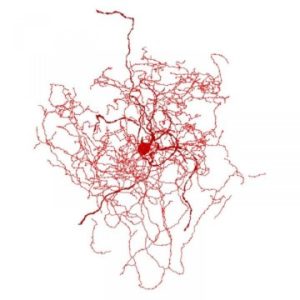Aug 28 2018
New Neuron Type Discovered in Humans
 Human brains are perhaps the most complex known structures in the universe (known to us), and while we have discovered a tremendous amount of information about them, there is still much to discover. Recently neuroscientists have discovered a new neuron (brain cell) type, so far discovered only in humans – the rosehip neuron.
Human brains are perhaps the most complex known structures in the universe (known to us), and while we have discovered a tremendous amount of information about them, there is still much to discover. Recently neuroscientists have discovered a new neuron (brain cell) type, so far discovered only in humans – the rosehip neuron.
Neurons are highly specialized cells in the brain and other parts of the nervous system. They have a general structure that includes a soma, which is the cell body, and projections called dendrites and axons. Generally dendrites are short and numerous and receive electrochemical signals from other neurons. Axons tend to be long and few (often only one) and carry signals away from the soma to other cells. Neurons are therefore a basic component of the nervous system circuit.
Neurons also tend to be either excitatory (increasing the firing of the neuron they synapse on) or inhibitory (decreasing the firing of the neuron they synapse on). Different neuron types are identified by their general shape and their neurochemistry – are they excitatory or inhibitory and what neurotransmitter do they use. The most common neuron type in the cortex is the pyramidal cell, which has a pyramid-shaped soma, a dense bush of dendrites, and one long axon. Pyramidal cells are excitatory and tend to use glutamate as their neurotransmitter.
The newly discovered rosehip neuron has a dendritic tree and soma that looks like a rose without its pedals, hence the name. I has very short connections and is inhibitory, using GABA (a major inhibitory neurotransmitter). So rosehip neurons seem to function as an important local break on pyramidal cell firing. This is an important new puzzle piece that will help neuroscientists model brain function more accurately.
It is also noteworthy that these cells have never been found in rodents. They also appear to activate genes that have been found only in humans. Of course, it’s difficult to demonstrate a negative, but the fact that our rodent brain models, which have been extensively studied, never revealed this neuron type is pretty convincing. Still, now that scientists have identified the rosehip neuron, they can more specifically look for it in rodents.
The study also does not determine if the rosehip neuron is found in other primates, which would not be surprising. So right now we don’t know if this neuron type is unique to humans (or perhaps hominids), or how extensively it is found in the primate clade, but it is probably not found outside the primate clade. We will see.
This highlights the limitations in using animal models to study brain function in order to extrapolate the findings to humans. Rodents are simply not a great animal model for the human brain. This is why neuroscientists needing to do animal research will use primates if they can. The new study used human autopsies to study actual human brains, which is ideal, but often can only be done post-mortem. We can image living brains, and this technology is advancing steadily, but we cannot slice them up. The exception to this is surgical specimens, but they tend to be pathological. Using all of these techniques together, however, we can build a detailed picture of the human brain.
I also like to point out the critical role of inhibition in brain function. People tend to naively think of circuits as primarily sending signals, but in living systems it is critical to also inhibit signals. Otherwise the brain would just be a mess of signal noise (that’s basically what a seizure is). In fact there is a baseline inhibitory tone to circuits in the brain, keeping things under control.
There are also entire regions and circuits in the brain that have a primarily inhibitory role, such as parts of the frontal lobe. These circuits literally inhibit behavior and feelings, and if these circuits are damaged, inhibited themselves (by alcohol, say) or malfunctioning that can result in disinhibited (out of control) behavior.
It is also important to realize that brain circuits have computational ability – they are living computers. Inhibitory control, such as with the rosehip neurons, therefore play a critical role in this computational function, and that is what the researchers have also found.
Finally, any time we find something new about how the body works that creates the potential to discover another mechanism of diseases or disorders. Perhaps a dysfunction or deficiency of rosehip neurons may be the mechanism of certain psychiatric disorders. That remains to be investigated. That, then, in turn may eventually lead to new therapeutic interventions. There are many steps between this basic research and translating it into anything practical, but you never know where new fundamental findings will lead.






